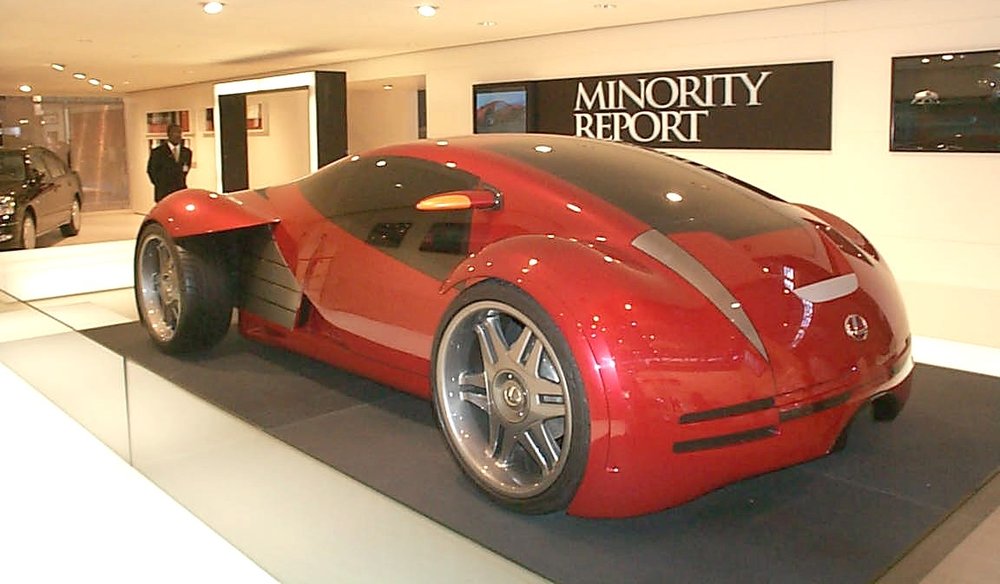
(Image: Wikipedia)
When Will We Be Able to Drive a Car like KITT?
Knight Rider led to a whole generation yearning to have a car as cool as KITT. A car that talked, thought and could help you do pretty much anything as you fought crime together.
With advancements in car technology picking up speed every year, we think it is the perfect time to try and figure out when exactly a car like KITT could be hitting our roads. We’ve also done the same for the Audi RSQ from I, Robot, the Lexus 2054 from Minority Report before finishing with the Spinner from Blade Runner 2049.
To work this out, the fine folks at Leasing Options looked at each futuristic aspect of these cars and found the best prediction as to when they will be commercially available. Obviously, not every feature of the fictional car will be practical, desirable or even legal. So, we’ve focused on the car’s most important features and figured out when they might be available.
KITT – Expected Release Date 2068
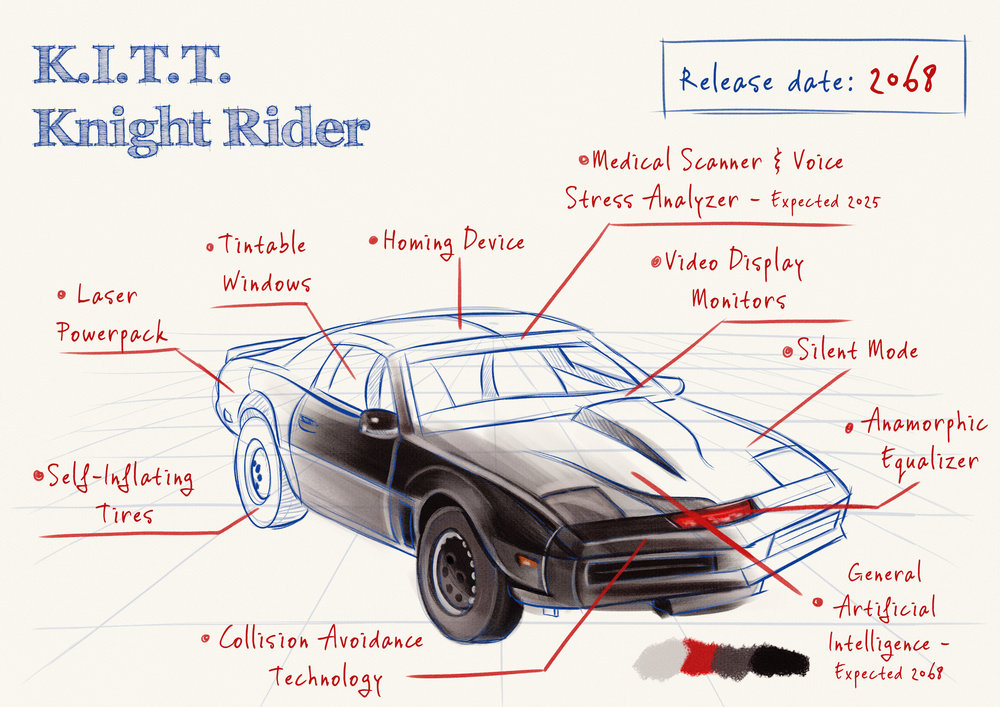
Unsurprisingly, a lot of the technology designed in Knight Rider now exists and has often been surpassed. Yet, largely due to the complexity of artificial intelligence, we’re still a long way off driving a car like KITT.
General Artificial Intelligence - Expected 2068
Elon Musk has been upfront about wanting to create a Tesla that utilizes A.I. In fact, he took the time out to answer in the affirmative when outright asked whether we’d get a KITT-like A.I. in Tesla cars in the near future.
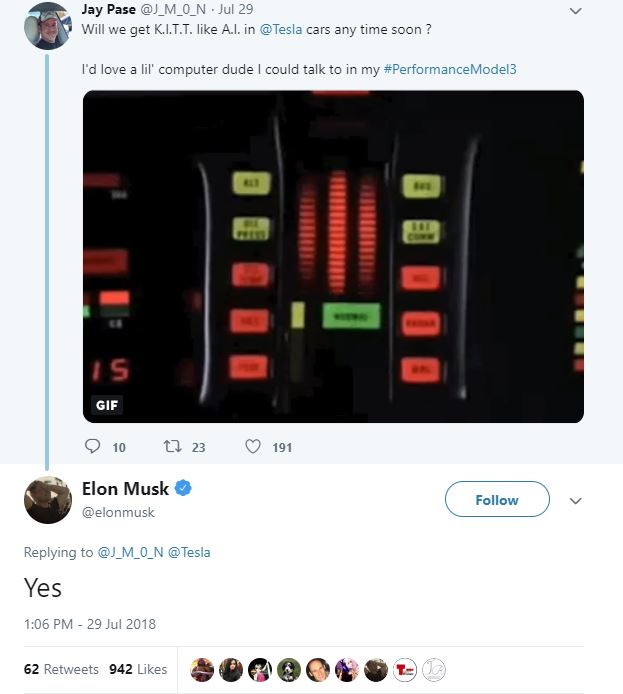
Sadly, we may have to wait a little longer than Elon is suggesting. KITT wasn’t just any old AI, he was a ‘General Artificial Intelligence’, meaning he could perform any intellectual task a human could.
So, when will General A.I. be achieved? A survey of experts in 2018 returned the median answer of 21-50 years. Given the steps required from creating a General A.I to making it commercially available and then figuring out the steps necessary to put it in a car, we’re taking the upper end of that estimate and calling it 50 years.

Anamorphic Equalizer - Exists
The KITT feature we all remember was, in fact, based on the iconic Cylon visor from Battlestar Galactica. For KITT, the Equalizer was its eyes, allowing KITT to see in X-ray Vision or infra-red.
A few different car makers have already implemented infra-red night vision into their cars. The first commercial vehicle to do so was the Cadillac Deville in 2000.
While there is no word yet on integrating X-Ray vision, it’s unlikely anyone will ever want it. Perhaps it can be a mod?
Silent Mode - Exists
KITT was able to sneak up on villains while in silent mode. While no 1ton vehicle is likely to ever be 100% silent, electric cars are currently able to run so quietly that legislation has been put forward to force car manufacturers to incorporate tech that alerts pedestrians of their approach.
Homing Device - Exists
KITT could be called through a homing beacon hidden in a golden pendant. Unsurprisingly, Google has created a similar feature for their driverless cars.
Laser Powerpack - Exists
Laser weapons have long been a science fiction staple. Recently, however, they have come that much closer to reality.
The US Navy has already included the world’s first active laser weapon, capable of destroying boats, drones and all sorts of other scary stuff on some of its warships.
Medical Scanner & Voice Stress Analyzer - Expected 2025
KITT was able to tell if the Hoff was A-Okay through his in-car medical scanners. While we’re not sure anyone will ever build a medical scanner that tells the driver if they have been poisoned, there have already been significant strides in this field.
Ford’s ECG Heart Rate Monitoring Seat has six embedded sensors that measure vital signs, allowing the car to tell if the driver is having a heart attack. It has been predicted that by 2025 advancements in biometrics will be able to track a driver’s stress levels, brain waves, fatigue and even facial expressions. Giving the car an early indication if anything is wrong with the driver that would require to the car to stop safely.
Tintable Windows - Exists
KITT was able to tint its windows at will to make them opaque. Automotive supplier Continental has already developed the technology to tint car windows through its Intelligent Glass Control System. This system tints windows at the push of a button by sending electric current to specially made glass.
While this would be in the driver’s control, it’s no stretch of the imagination that a car controlled by General A.I could manage to do it itself.
Self-inflating Tires - Exists
In the alliteratively titled episode Slammin' Sammy's Stunt Show Spectacular KITT shows off its self-inflating and deflating tires. While there are a few instances we can think of that where deflating tires would be advantageous, tires that inflate themselves would be cool.
Luckily, this technology has already been created. SIT – The Self Inflating Tire, developed by CODA of the Czech Republic, uses the energy of the wheel to self-inflate the tire as required, meaning tires are always at the optimum pressure level.
Fuel Processor (hydrogen) - Exists
For a car in the 80s, KITT was pretty environmentally friendly. Although Elon wouldn’t approve, KITT’s turbo engines were powered by Hydrogen. The first Hydrogen car released was the Toyota Mirai in 2015.
Of course, being the super-advanced car that it was, KITT didn’t just rely on Hydrogen. It could use a mix of sources, making it effectively a hybrid car: like the Prius.
Video Display Monitors - Exists
KITT had two video display monitors to display all of the information Hasselfhoff needed to fight crime. It's fair to say that his mind would have been blown if he could have seen the vast arrays of monitors and head up displays available today.
Collision Avoidance Technology - Exists
As part of being a self-driving car, KITT was able to deploy collision avoidance systems to avoid crashing into things. This first modern car avoidance system was developed by Hughes Research Laboratories in Malibu (1995).
Volvo was the first car maker to introduce pedestrian detection and avoidance tech when they created the Volvo XC60.
Weird stuff we’ll probably have to do without
KITT came with a host of other features. Some aren’t possible at all, some would be illegal and other simply impractical. With that in mind we’ve left out features like Seat Ejection System, most of the military tech like flamethrowers, the ability to jet on water and the money dispenser.
We kept in the Laser Powerpack, because lasers are cool.
Audi RSQ – I, Robot
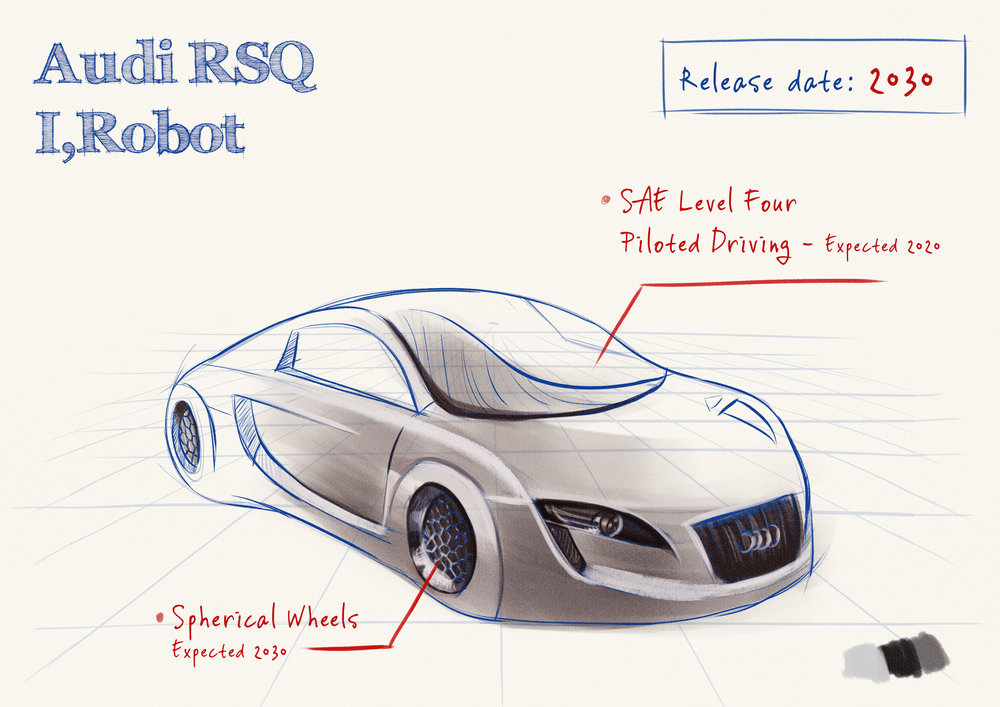
The Audi RSQ was probably the most memorable part of the otherwise forgettable Will Smith film I, Robot. The car was a nifty piece of product placement for Audi, who built a mid-engine concept car for the movie. It was designed to be a beautiful car that was both futuristic but still realistic.
SAE Level Four Piloted Driving - Expected 2021
The Audi RSQ is an SAE level four self-driving car, it is able to drive itself almost all the time without human input and the driver should not have to take control for safety reasons. The driver may need to take control in “unmapped areas” but otherwise the car requires no input from the driver. Indeed, one of the ways we know Will Smith is the “reckless leading man” of the film is his passenger’s shock when the Fresh Prince takes the controls at high speed.
While ride-hailing level four vehicles have already been developed, current predictions state that level four autonomous vehicles are likely to be available for the consumer market early in the next decade, reaching 1% market penetration by 2025.
Suitably, Audi themselves have got close to a level four self-driving car with the Audi R8. The R8 is level three and will be released in 2019.
Spherical Wheels - Expected 2030
In the movie, the Audi RSQ is able to move in pretty much any direction it wants due to having spherical “wheels.”
Goodyear has already announced a concept tire that does this and more: the Eagle 360 Urban. Designed for level five vehicles, the Eagle 360 Urban is AI-powered. Allowing it to adjust to road types and communicate with the car’s AI. It can even provide alerts to the driver when the tire requires maintenance.
Lexus 2054 – Minority Report
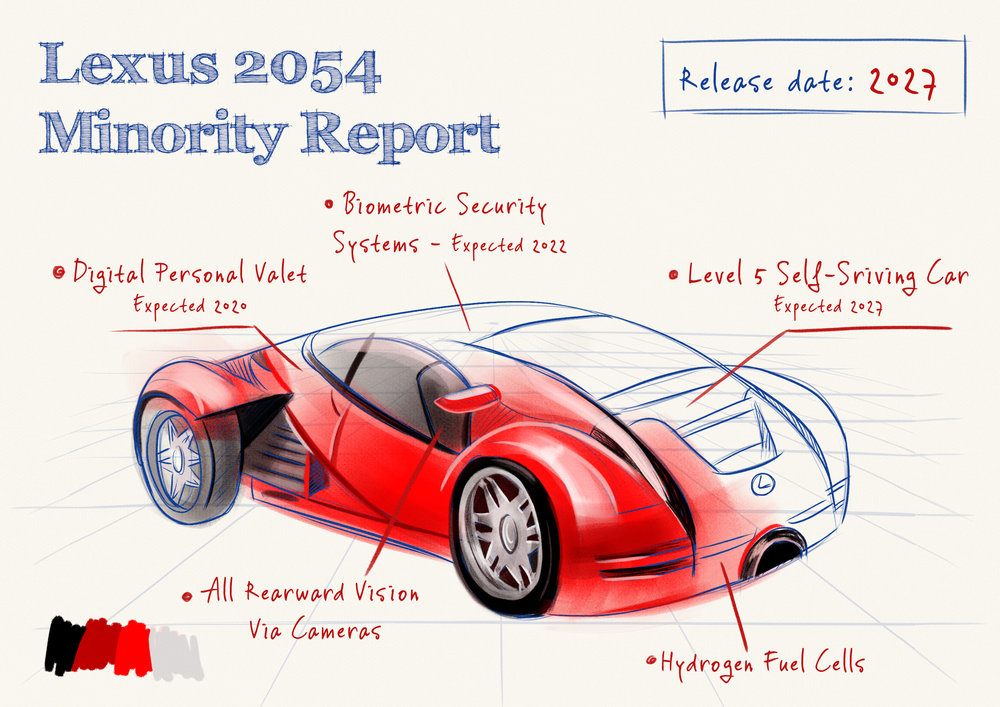
Like many Tom Cruise films, Minority Report is a great looking movie that was a little light on substance. What didn’t lack substance was the Lexus 2054. Designed for the movie in 2002, the Lexus 2054 was meant to look like a car from the 2050’s. Instead, it looks like we could own it by the end of the next decade.
Level 5 Self-Driving Car - Expected 2027
The Lexus 2054 went one better than the Audi RSQ by being a level five self-driving car. While the technology for level 5 self-driving cars isn’t too far behind Level 4 cars, we will have to wait a few more years to be able to drive one, or not as the case may be. This is largely due to the massive legal implications of such vehicles being on the road at the same time as normal driver-operated vehicles.
Due to these challenges, and despite bold statements by some of the auto manufacturers, it’s likely that we’ll have to wait until 2027 before we get to enjoy a level five self-driving car.
Hydrogen Fuel cells - Exists
As we stated above, it’s looking increasingly like Hydrogen fuel cells may not be powering the cars of the future. But that’s not what people thought back in 2002.
Biometric security systems - Expected 2022
Biometrics is one of the growing fields in the automotive industry and is predicted to grow from $442.7 million to $854.8 million by 2021.
You can actually buy fingerprint access and voice recognition access systems from a company called United Linkers Biometric & Robotic Solutions right now.The reasons such systems are not widely available as standard is simply because of the complexity of the technology coupled with the long design times for cars. However, a number of cars (including the Genesis Essentia and the Volkswagen I.D. Vizzion) are expected to be released in the next decade.
All rearward vision via cameras rather than mirrors - Exists
The move to replace cameras with mirrors has gathered pace in recent years. And, if you’re lucky enough to be able to pick up the latest Lexus ES in Japan, you can already drive a car that’s replaced rear view mirrors with cameras, making blind spots a thing of the past.
Digital Personal Valet -Expected 2020
The Lexus in Minority Report is able to do things like a book you a table at a restaurant. This is a feature that’s very close to reality, with the likes of Apple, Google and Amazon leading the way.
Google appears to be winning the race in this regard, with the Google Duplex feature it announced at 2018’s I/0 developer conference. This feature allows Google Assistant to book appointments for you over the phone, by actually sounding like a real person. So if you said ‘Book me a table at the Ritz for 9’ it would actually call the restaurant and ask about availability and seat preference etc.
While there is no official release date for this feature as of yet, it is already been tested in specific regions, so an estimate of 2020 seems realistic.
Spinner – Blade Runner 2049
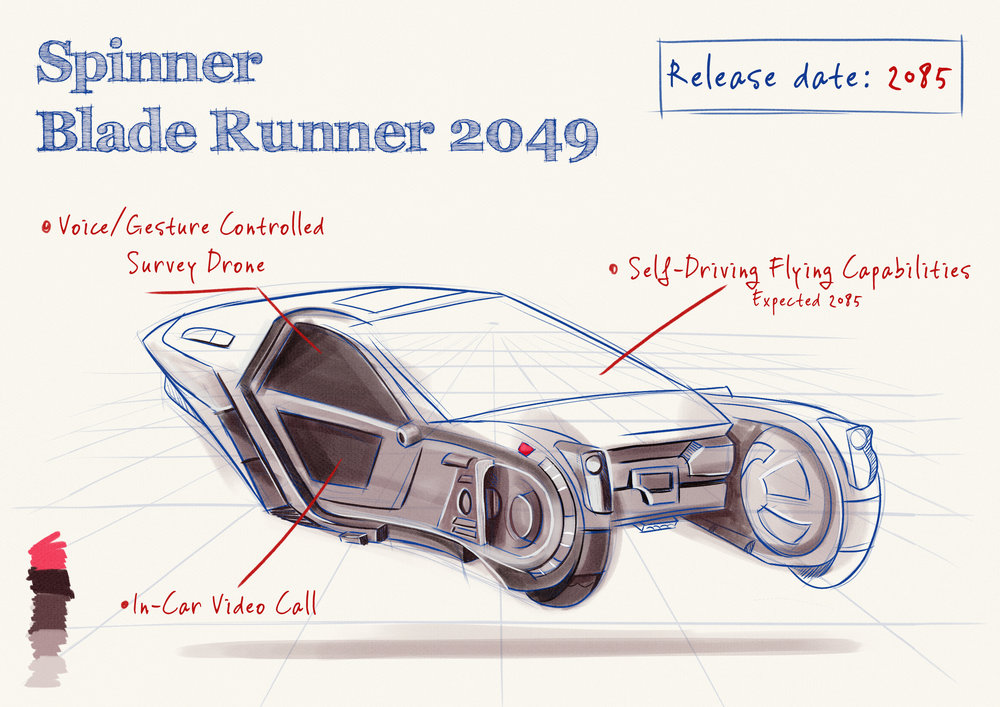
The coolest flying car ever to be seen on screen. The Spinner perfectly encapsulated the gritty, futuristic, cyberpunk world of Blade Runner. We’ve gone for the Spinner as seen in Blade Runner 2049, rather than the original, as we think it’s cooler.
Voice/gesture activated detachable drone & camera - Exists
In one of the first scenes of Blade Runner 2049, K uses a voice-activated drone to take a survey of the area surrounding a ‘farm’, which uncovers the bones that revealed that a replicant had given birth to a child. A discovery that ultimately kicked off the plot.
While no-one has yet developed that particular piece of kit, all the component parts already exist.
We’ve been able to map root systems of trees for some time. And Yuneec has already released the Mantis Q, a voice-activated camera drone. There are also high-tech drones currently on the market able to take detailed agricultural and topographical data/images. Therefore, while we can’t find an example of a drone with the specific features of the drone in Blade Runner 2049, it is clearly within our grasp.
In-car video calls - Expected 2021
Clearly, this is possible now, you just shouldn’t be using your phone while driving. Therefore, you will need to wait until level four piloted cars at least before you can utilizing in-car video conferencing. The Mercedes F 015 plans to have amazing wrap around touchscreens, allowing you to take video calls in a lot more style than K does in Blade Runner 2049.
Self-driving flying car - Expected
To make something a true flying car like a Spinner, it needs to be able to drive on the ground, fly and be able to achieve vertical takeoff.
There are always reports of flying cars about to be introduced to the market. Indeed, the next few years will see an influx of flying cars. However, all these cars will require a pilot's license and when you use them to fly, you will have to follow predetermined routes, landing and taking off from predetermined airports or landing pads.
That’s not what a true flying car is all about. A true flying car needs to be able to take you from the door to right outside your work. In order for this to take place, it’s not necessarily the technology that is holding us back. It’s the lack of real world and legal infrastructure.
Our cities and laws are not set up for all of us to be flying to work. To start with, no government is going to let just anyone fly a car without a license and checks, so they will have to be level five self-piloted.
Given that level-five self-driving cars aren’t expected to have near complete market penetration until 2049, and all of the legal and real-world hurdles to be dealt with, it’s touch-and-go whether it’s plausible that we’ll be getting a car as cool as the Spinner much before the turn of the century. With that in mind, we’ve been optimistic and said 2085. By which point we may actually have replicants to worry about.

LOGO DESIGNED BY MEENTS ILLUSTRATED
from REVIEW BLOG - Every Movie Has a Lesson https://ift.tt/2SaZFdy







No comments:
Post a Comment